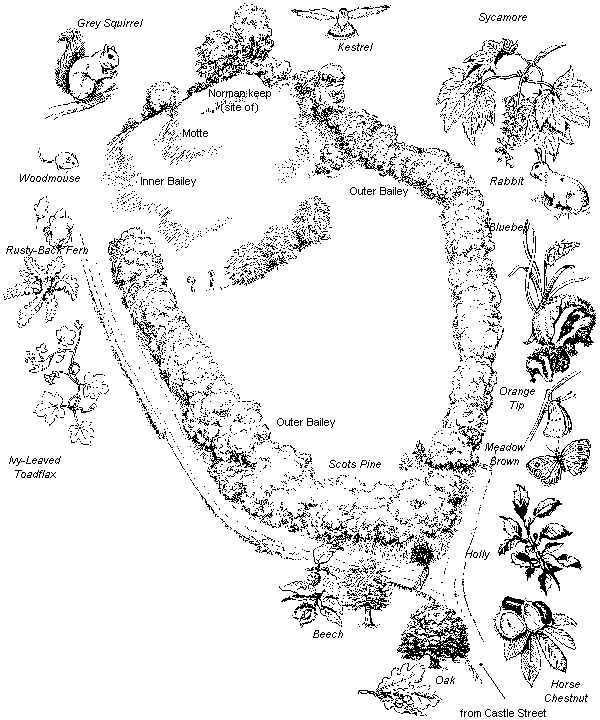Millennium Project
The Castle Grounds are now a civic amenity, posted with chestnut and sycamore trees where once the Norman lord's guard stood. Townsmen and farmers milled about in the protection of the castle's outer enclosure where now boys wearing Man-U shirts practise their football skills. On a summer's day young mothers share the shade of a leafy beech whilst their toddlers capture ladybirds and learn the principle of gravity.

An annotated map of the area represented by this drawing of the Castle Grounds is available (PDF).
The castle, on land granted to Bishop Odo of Bayeux by William the Conqueror, was built not long after 1086. Strengthened in the 1100s, the castle was found less useful by the 1200s. By the end of the 14th century, the castle had largely gone. Thereafter the stones were sold, some were "borrowed", and all were carted away. The Normans were not the first to occupy this land; Saxons did so in the years before 1066. In time, new uses were found for old ground: timber and pasturage in the 18th century, a resort of the local gentry for sport and recreation in the 19th.
Surprisingly, there are 23 kinds of herbaceous plants in the Grounds, including bluebells and lords and ladies; 26 species of trees and shrubs, including elm, willow, ash and pine; and 3 species of ferns. The land is well suited for uses other than natural history. There is a daredevil's run, on the northern embankment, where sledges make their way on the first snowfall; elsewhere, a tall chestnut tree lends a strong arm to boys who leap into space on a dangling rope; and every day, dogs bring their keepers here to enjoy the air and the special spirit of the Castle Grounds.
Deddington's Hedgerows
Insects, birds, and wild mammals are more abundant where hedges have a mixture of trees and shrubs, are wide and densely packed with vegetation, run for long distances without gaps, and connect with other hedgerows of the same kind. There is more wild nature in the 870 or so hedgerows of Deddington parish than in its few wooded sites. If you get down on your knees and take a hedgehog's view, the bottom of the hedgerow is a hobgoblin's world of crisscrossing branches, spiny passages, thick leaf mould, new stems from old stumps, and worms and beetles. The hedgerow is a zoological garden and the farmer its keeper.
